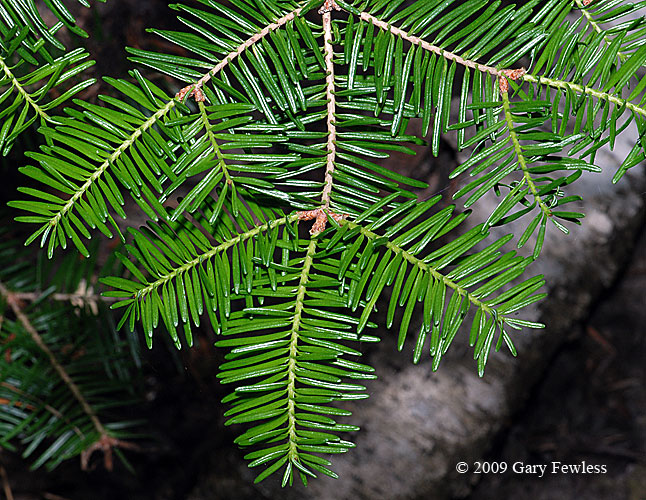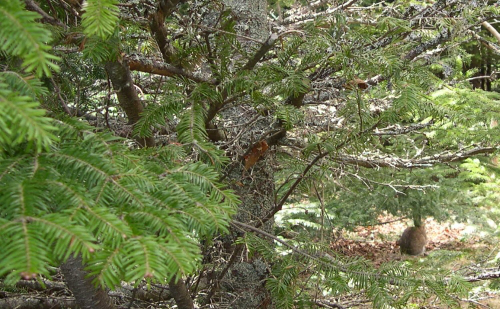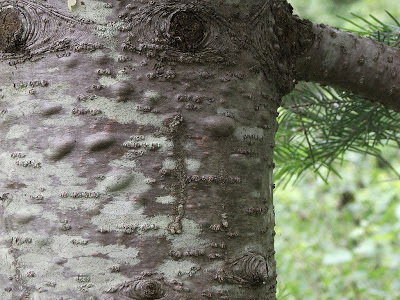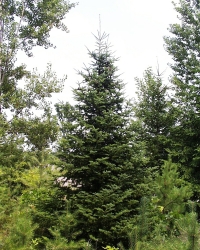 Balsam fir is a coniferous tree native to northern Wisconsin and the rest of the Lake States. It has the largest distribution of the North American firs, extending across southeastern Canada, south through most of the Midwest, and east through New England. It grows from sea level all the way up to 50 feet below the summit of Mount Washington, the tallest mountain in its range (that’s from sea level to 6,238 feet elevation!). Balsam fir has a dense, conical crown with a slender tip (think of the shape of the “perfect” Christmas tree). The needles are flat and are arranged so that they are in one plane, meaning they mostly point out from opposite sides of the branch. If you look at a balsam fir twig closely, you will see that the needles are attached to all sides of the twig, but as the needles grow, they twist so that most of them are parallel to the ground. Unlike most conifers, the cones of balsam fir point upwards from the branch instead of hanging down. When the cone is mature, the cone scales fall off, so it is rare to find an in-tact mature cone on a tree. Balsam fir is truly a northern species and is an important part of northern mixed forests or boreal forests.
Balsam fir is a coniferous tree native to northern Wisconsin and the rest of the Lake States. It has the largest distribution of the North American firs, extending across southeastern Canada, south through most of the Midwest, and east through New England. It grows from sea level all the way up to 50 feet below the summit of Mount Washington, the tallest mountain in its range (that’s from sea level to 6,238 feet elevation!). Balsam fir has a dense, conical crown with a slender tip (think of the shape of the “perfect” Christmas tree). The needles are flat and are arranged so that they are in one plane, meaning they mostly point out from opposite sides of the branch. If you look at a balsam fir twig closely, you will see that the needles are attached to all sides of the twig, but as the needles grow, they twist so that most of them are parallel to the ground. Unlike most conifers, the cones of balsam fir point upwards from the branch instead of hanging down. When the cone is mature, the cone scales fall off, so it is rare to find an in-tact mature cone on a tree. Balsam fir is truly a northern species and is an important part of northern mixed forests or boreal forests.
 As I’ve already told you, Abies balsamea is an incredibly important wildlife tree. Deer, moose, rabbits, and many species of birds use balsam fir stands for thermal cover because the dense foliage cuts down on wind and insulates the area. Check out the photo to the right and spot a rabbit taking cover under the balsam fir! Additionally, the thick foliage also intercepts the snow before it hits the ground, making it easier for animals to move around or run from predators that might sneak up on them. Balsam fir is unpalatable to deer who only use it as winter cover, however, many species of wildlife do rely on balsam fir for food. Moose rely on balsam fir as their chief food source during the winter. Mice and voles eat the seeds and the bark. Red squirrels feed on the seeds, bark, wood, and flower buds. Black bear strip the bark and eat the green wood underneath. Balsam fir stands that have been infested with a pest called the spruce budworm (a misnomer seeing as this insect prefers fir trees over spruce trees) are a very important source of food for birds of all kinds who come to feed on the spruce budworms.
As I’ve already told you, Abies balsamea is an incredibly important wildlife tree. Deer, moose, rabbits, and many species of birds use balsam fir stands for thermal cover because the dense foliage cuts down on wind and insulates the area. Check out the photo to the right and spot a rabbit taking cover under the balsam fir! Additionally, the thick foliage also intercepts the snow before it hits the ground, making it easier for animals to move around or run from predators that might sneak up on them. Balsam fir is unpalatable to deer who only use it as winter cover, however, many species of wildlife do rely on balsam fir for food. Moose rely on balsam fir as their chief food source during the winter. Mice and voles eat the seeds and the bark. Red squirrels feed on the seeds, bark, wood, and flower buds. Black bear strip the bark and eat the green wood underneath. Balsam fir stands that have been infested with a pest called the spruce budworm (a misnomer seeing as this insect prefers fir trees over spruce trees) are a very important source of food for birds of all kinds who come to feed on the spruce budworms.

One other super-cool feature of the balsam fir: its resin blisters! All balsam firs, except very young or very old trees, have warty-looking bumps covering their trunks. These lumps are actually little packets, or blisters, of resin (also called pitch) just under the first layer of bark. Pitch is not to be confused with sap. Sap is basically water with sugars, vitamins, hormones, and enzymes that serve as nutrients for the tree; it is found in the xylem and phloem cells of the tree. Resin, or pitch, is very different. It is a highly viscous substance used by the tree to plug up wounds or defend itself from insect or pathogen infestations. To simplify, sap is the substance we make maple syrup out of in the springtime; resin is the substance that eventually hardens, fossilizes, and turns into amber. With resin blisters all over the trunk of the tree, any insect, bird, or pathogen that comes along and takes a bite out of our balsam fir will be rewarded with a big sticky glob of resin in the face.
 Balsam fir is not often used as a street or landscape tree because it demands a well-drained soil with plenty of moisture, which is a hard environment to create along a street or in an urban yard. It is, however, very widely used as a Christmas tree. For four hundred years, balsam fir has been either the most popular or second-most popular Christmas tree in North America. Features of the tree that make it an ideal Christmas tree are that it has a really nice deep green color, it has a great conical shape, after the tree is cut the needles stay on the tree for a long time, and it has a wonderful smell. A 6 or 7 foot tree is usually between 10 and 12 years old. Walk down your street and take a look at the trees that you or your neighbors have put out on the street for collection - I’m willing to bet that if you walk past 10 discarded Christmas trees, at least one of them is a balsam fir!
Balsam fir is not often used as a street or landscape tree because it demands a well-drained soil with plenty of moisture, which is a hard environment to create along a street or in an urban yard. It is, however, very widely used as a Christmas tree. For four hundred years, balsam fir has been either the most popular or second-most popular Christmas tree in North America. Features of the tree that make it an ideal Christmas tree are that it has a really nice deep green color, it has a great conical shape, after the tree is cut the needles stay on the tree for a long time, and it has a wonderful smell. A 6 or 7 foot tree is usually between 10 and 12 years old. Walk down your street and take a look at the trees that you or your neighbors have put out on the street for collection - I’m willing to bet that if you walk past 10 discarded Christmas trees, at least one of them is a balsam fir!





